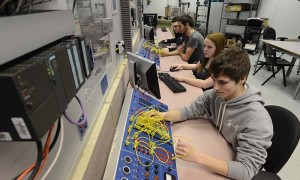Over the years many issues have been debated in regards to their impact on student learning and engagement in the middle years. It is now at the stage that it is becoming too complicated for the average teacher to sift through and work out what is important, and where to begin to make a start. Although a large body of research has been conducted, it has rarely been synthesized into a usable form that can be applied easily by teachers. This paper aims to sort through the various issues at play, and determine which are really important for the average classroom teacher to understand and to implement.
One of the most helpful statements on middle schooling that I have ever found was written by American educator, James Beane in 1996:
“We believe that young people have a right to be intelligent, to be well informed, to search for meaning in their world, to be engaged with significant issues, to do authentic work, to learn the whole story, to think critically, to form values, to make judgments, to be respected.” (Beane, 1996, p.48)
Instead of speaking in terms of curriculum development or organizational structure, Beane addresses directly the rights and needs of young adolescents. These are incidentally rights that we adults tend to take for granted. We get frustrated at work when what we are doing seems to require a low level of thinking and engagement from us, has very little meaning in the real world, is never going to be used for anything significant, shows only a partial view of the issue, requires no informed judgments from us, and when we do not have the respect of our colleagues and bosses. It is therefore hardly surprising that young adolescents experience similar frustrations when we make their schooling such that they feel stupid, poorly informed, unable to do anything of real world significance, forced to sit for assessment that has little point, little significance and no relation to tasks in the real world, unable to express opinions and make judgments, and failing to earn any respect from peers or adults. Frankly, if I was forced to work under those conditions I would have resigned long ago.
It comes as no surprise therefore that we experience significant disengagement from schooling by young adolescents. Imagine the average class of year nine boys and you will generally not be imagining students who are excited about learning, motivated about their assessment and involved in school decision making. They are unlikely to put in more than the minimum effort, and that only if they consider the subject studied to be important for later schooling, university or career moves in spite of its seeming irrelevance now. It requires a significant level of dedication and motivation to continue on working and learning in a situation that actively opposes most self-determining behaviours.
A number of educational theorists have written about adolescent developmental needs. These have been studied to determine what it is that adolescents need to be engaged in schooling. A relatively comprehensive list includes the following:
The need for –
1. Competence and achievement thereby improving self-confidence.
2. Self-exploration and definition opportunities.
3. Positive social interaction with adults and peers.
4. Physical activity.
5. Meaningful participation in families, school and communities.
6. Routine, structure and clear limits, together with growth towards independence.
7. Diversity.
8. Opportunities to explore concepts and generate ideas from concrete experiences. To think in ways that become more abstract and reflective.
9. Opportunities to explore values and decision making, and growing awareness of the social and political world.
10. Creative expression.
(Eyers, 1992; NMSA, 2000a; Van Hoose and Strahan, 1988).
A good summary of this is the finding by the Schools Council in 1994 that in order to be effective, “middle schooling should be challenging, filled with variety, responsive to the learning needs, interests and concerns of young adolescents and empower its students with self-confidence and a respect for learning” (Berkley, 1994, p.10).
Many school organizational aspects have been considered to determine their impact on these developmental needs. These include: authority and power structure, personnel practices, professional development of teachers, curriculum design, pedagogical practices, assessment and evaluation, parental and community involvement, scheduling practices and teacher/student ratios in learning communities. See the Figure 1 below for a comparison of these organisational aspects between “traditional schooling” and what is being termed “middle schooling”.
Organizational Aspect Traditional schooling Middle schooling
Authority/power structure Top down Democratic. Teachers empowered as decision makers. Student input in all decisions. Negotiation as the key (Apple and Beane, 1995).
Personnel practices Individual teachers / subject teams Inter-disciplinary teams (Maciver, 1990).
Professional development Little/none Regular and often as the basis for improving practice.
Curriculum design Discipline based Integrated curriculum based on students personal and social concerns without regard for subject-area boundaries (Beane, 1996).
Pedagogical practices Lectures and textbooks Based on constructivist principles (hands on, minds on) and Project/ problem based learning (Pate, Homestead and McGinnis, 1997).
Assessment and evaluation Tests Authentic Assessment: disciplined inquiry, integration of knowledge and value beyond evaluation (Burke, 1997).
Parent and community involvement Little/none High (Fry, 1994).
Scheduling practices 40 or 50 minute set periods Flexible timetable involving large blocks of time (Hackman and Valentine, 1998; Fogarty, 1997).
Learning communities Large student: teacher ratio Small learning communities (Felner et al, 1997a).
Many of the organisational aspects of middle schooling included above were recommendations of the Carnegie Council’s “Turning Points” report:
National and State Recommendations for Transforming Middle -Grades Education
Create small, personalized communities for learning.
Teach a core academic program.
Ensure success for all students.
Empower teachers and administrators to make key pedagogical, management, and budgetary decisions.
Staff middle-grades schools with teachers who are specially trained to teach young adolescents.
Improve academic performance through fostering the health and fitness of young adolescents.
Reengage families in the education of young adolescents.
Connect schools with communities.
Figure 1 from Felner et al, 1997a
While each of these aspects is important in middle schooling, some are more important than others. I believe that running an integrated curriculum with authentic assessment in a democratic classroom fulfils all of the student developmental needs, and is much simpler to manage for the average classroom teacher.
Integrated curriculum is not using a theme oriented approach and seeing what each subject can contribute. Although this is often a good starting point, it is not the end product. Curriculum integration involves basing the learning experience on significant issues and problems that have been collaboratively identified by teachers and students, without regard for separate subject boundaries (Beane, 1997). It does not ignore subject specific knowledge, but acknowledges that if we start with the answers instead of the questions then we miss a vital part of the learning process and end up with an inferior product. It does not teach maths and English and science, but teaches students how to solve problems that involve knowledge from a wide range of sources which may or may not include knowledge from traditional subjects.
Integrated curriculum cannot be achieved in a classroom which has a traditional authority structure. If a curriculum is based on questions, then class time must be based on seeking answers to those questions. If students are not given responsibility for answering the questions themselves, then integrated curriculum ceases to have significance. Why would you spend your time seeking an answer that you knew was going to be corrected soon anyway? If we are dealing with significant problems then there will not be only one answer, so multiple interpretations must be allowed. Simple answers only occur for simple problems, not complex and significant ones. So, if students are given responsibility for seeking answers to questions, then the class structure must be arranged to encourage this. Students must be given time to seek answers and the responsibility for finding answers. If they have truly been given the responsibility for finding answers to significant problems, then the authority structure must not dictate when, where, how and in what context they may work. This would negate their responsibility for finding the answers. The class timetable and authority structure must necessarily be negotiated with individuals in their situation rather than being applied in a top-down structure that lacks flexibility.
When students come up with real answers to significant questions, it is unlikely that all of their answers will be the same. Traditional assessment structures are often based on producing the ‘correct’ answer to a question. How could these structures fit with questions that do not produce ‘correct’ answers? Instead we must use authentic assessment – that which involves integration of knowledge and has value beyond mere evaluation purposes. If we are using real life questions, then it makes sense that we would assess their real life answers and applications. This may mean that every student produces different assessment forms. We must be flexible, and not think that one form is better than another. Students must be allowed to demonstrate what they have learned in real-life contexts, over time periods, and on multiple occasions.
So how do these address student developmental needs?
Competence and achievement
Students undergoing a program of curriculum integration achieve at a higher level than their peers (Aitkin, 1942 – in Beane, 1997). Achieving at higher levels increases the sense of competence. “Curriculum integration is known for giving more young people more access to knowledge; for encouraging them to be intelligent, to use their minds critically and creatively; for using knowledge in more sophisticated ways; and for giving young people a chance to use knowledge for problem solving” (Beane, 1996, p.10). This can cause problems in certain spheres as some adults fear giving students too much access to knowledge and power.
Self-exploration and definition
“The central focus of curriculum integration is the search for self- and social meaning” (Beane, 1995, p.616). Therefore by definition it meets the developmental needs for self exploration and definition, as well as growing awareness of the social and political world.
Positive social interactions with peers and adults
According to Beane, the emphasis in IC is on teacher-student and student-student collaboration, which is necessary for curriculum planning and negotiation. Themes such as “getting along with others” also promote this (Beane, 1997).
Physical Activity
IC does not seem to promote physical activity except as a by-product of a constructivist approach.
Meaningful participation in families, school and communities.
While there is not clear data showing an increase in family, school and community participation, the work by Pate, Homestead and McGinnis (1997) indicates that students in an IC classroom look increasingly towards families and communities for information and resources. In their year-long study, the McHome team found that family and community involvement increased during their IC program.
Routine, structure and clear limits, together with growth towards independence.
Setting up a democratic classroom based on notions of rights and responsibilities is fundamental to any IC program (Apple and Beane, 1995). Ideally, the class members would decide together on regulations for conduct (Pate, Homestead and McGinnis, 1997), thereby understanding and appreciating the routines and limits. In an IC classroom students would also negotiate the curriculum with the classroom teacher and thus have a clear understanding of the structure from the start (Beane, 1997).
Diversity.
Diversity in IC comes from a curriculum that deals directly with student concerns. Student concerns are varied (Beane, 1997), and often show evidence of deep thinking about the world that we are living in. The very nature of these concerns demands diversity in curriculum. This need for diversity is actually a concern for some teachers who feel ill-prepared for dealing with a curriculum with which they have no familiarity (George, 1996). However, teachers with a real concern for adolescents need to be prepared to put aside their fears and insecurities, and focus instead on what is best for their students.
Opportunities to explore concepts and generate ideas from concrete experiences.
To think in ways that become more abstract and reflective.
According to Beane (1991, p.9), “genuine learning involves interaction with the environment in such a way that what we experience becomes integrated into our system of meaning”. This interaction with the environment is fundamental to a constructive approach of exploring concepts and generating ideas from concrete experiences (Appleton, 1997; Tippins, Tobin and Nichols, 1995). Beane also argues that as IC opens a way for critical inquiry into real issues, knowledge is pushed to the level of problem solving and application (Beane, 1997). This would promote abstract and reflective thinking.
Opportunities to explore values and decision making, and growing awareness of the social and political world.
IC provides for exploration of values and decision making in both the personal and social worlds, because of its basis in the personal and social concerns of students. True curriculum integration fits closely with Symes and Preston’s notion of an emancipatory perspective, one that is “emancipatory and empowering for teacher and student alike, within a context of social justice” (Symes and Preston, 1997, p.73), and has “a bifocal commitment to the individual and society” (Symes and Preston, 1997, p.77). Such an approach attempts to avoid the selective political ideologies which play more than a small role in the “sort and select” system inherent in the separate subject approach (Beane, 1995).
Creative expression.
Within an Integrated Curriculum meanings are created by the students and not imposed by adults (Beane, 1991). This leaves room for a great deal of creative expression by students, particularly when used in conjunction with constructive pedagogy, project based learning and authentic assessment.
Effective Middle Schooling:
Effective middle schooling is organized in such a way that it meets the developmental needs of adolescents. It is democratic in nature, based on principles of negotiation. Students and teachers work together in small communities with parents and community members, and are responsible for making decisions about their teaching and learning. Together they study issues that are of personal and social significance to them. As they actively create meaning through concrete experiences, they learn about the world around them and how it operates. In such a context the learning is also the assessment, and has value outside the classroom. Limited time is not an issue, because the schedule is dependent on the learning, not the other way around. Professional development takes place continually.
Effective middle schooling cannot be achieved just by changing the organizational aspects of traditional schooling. It requires an ideological change on the part of educators and administrators alike (Norton and Lewis, 2000). But as Felner et al (1997b) show, for those who persist with change the rewards are many.
Article Source: http://EzineArticles.com/584829










